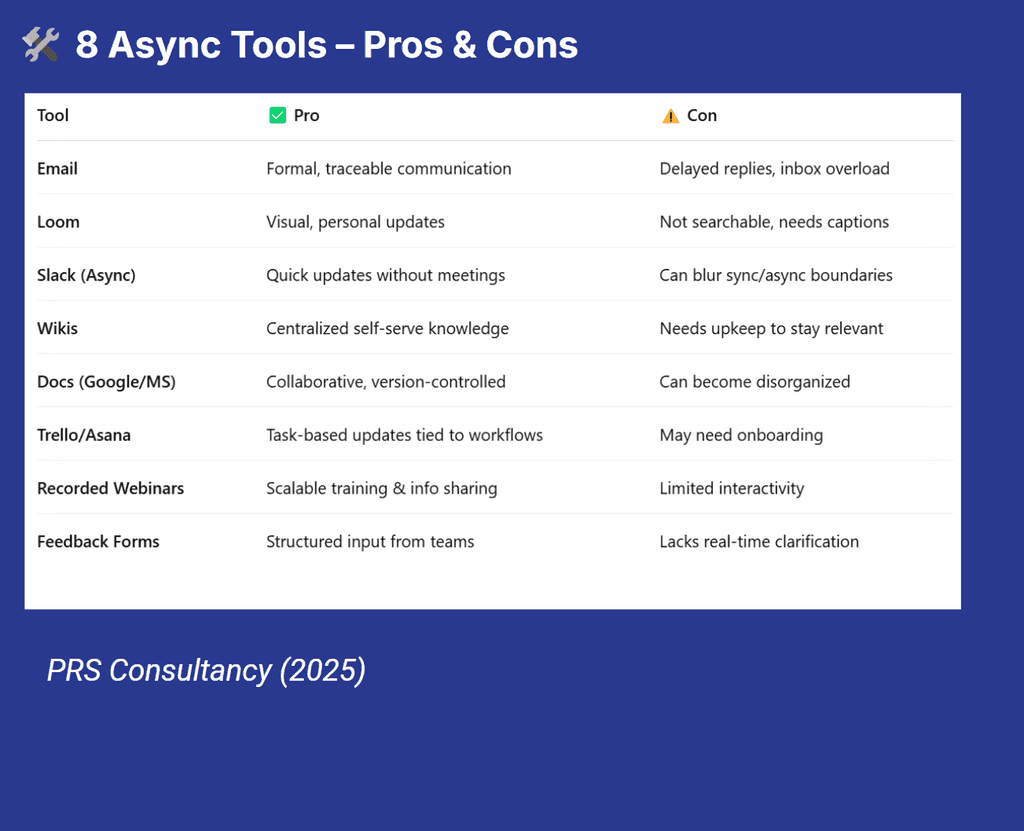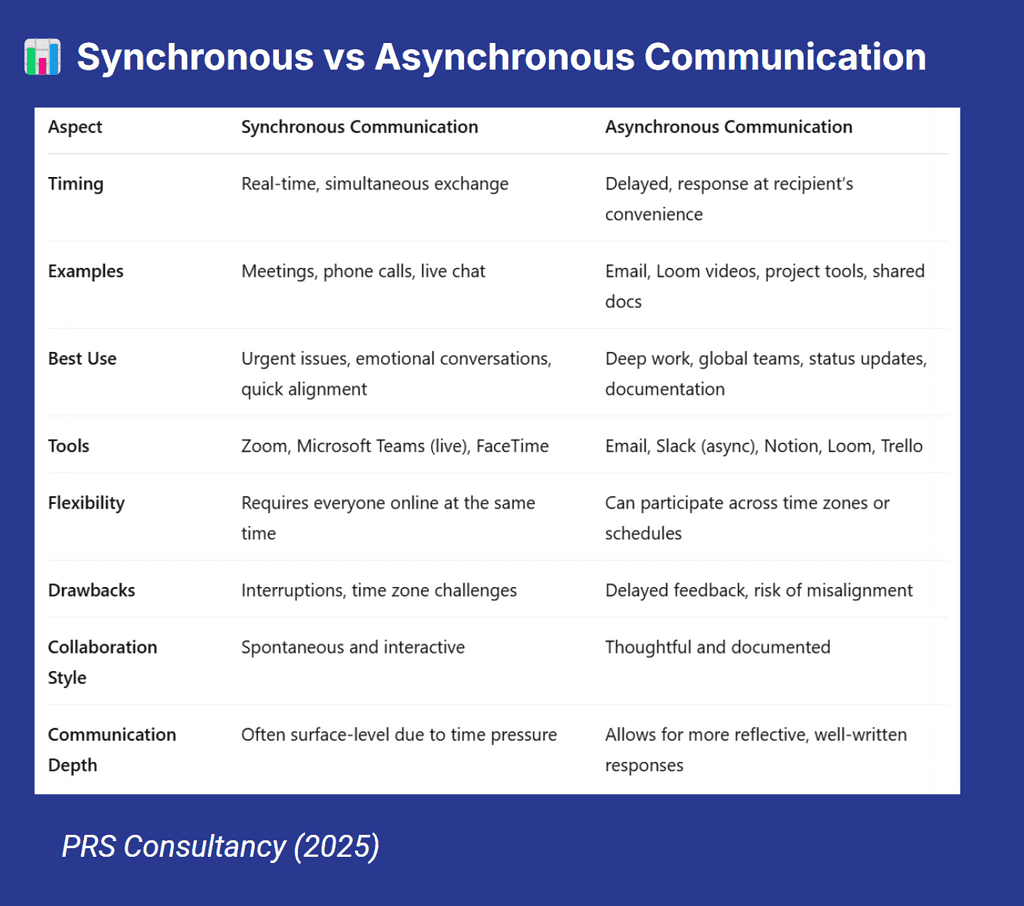Asynchronous communication refers to the exchange of information without the expectation of an immediate response. Unlike real-time or synchronous communication (like phone calls or video meetings), asynchronous methods allow recipients to respond at their convenience. This flexibility is increasingly vital in hybrid and remote work environments, global teams, and organizations striving for focus-driven productivity.

1. Email
Email remains the cornerstone of business communication due to its versatility and record-keeping benefits.
Use Case: Weekly project updates, client correspondence, policy distribution.
Pros:
- Enables detailed documentation and easy retrieval.
- Supports attachments and formatting.
- Allows communication across time zones.
Cons:
- Delayed responses can stall progress.
- High volume leads to clutter and missed messages.
2. Project Management Tools (e.g., Asana, Trello, ClickUp)
These platforms facilitate task-based communication tied to workflows and deadlines.
Use Case: Assigning tasks, updating project status, team collaboration.
Pros:
- Centralizes project discussions.
- Tracks accountability and deadlines.
- Integrates with other tools like Slack or email.
Cons:
- May require training or onboarding time.
- Risk of over-segmentation of discussions across tools.
3. Recorded Video Messages (e.g., Loom)
Video messages add a personal touch and clarity to asynchronous updates.
Use Case: Leadership announcements, walkthroughs, or demos.
Pros:
- Enhances emotional tone and visual cues.
- Reduces need for meetings.
- Easily replayable for better comprehension.
Cons:
- Not searchable like text.
- May require subtitles for accessibility.
Learn more: Loom on asynchronous communication
4. Internal Wikis or Knowledge Bases (e.g., Confluence, Notion)
These centralized repositories support organizational knowledge sharing.
Use Case: Onboarding guides, SOPs, FAQs.
Pros:
- Encourages self-service learning.
- Reduces repetitive questions.
- Always accessible and updatable.
Cons:
- Requires consistent maintenance.
- May become outdated or underused.
5. Instant Messaging (When Used Asynchronously) — e.g., Slack, MS Teams
Though designed for quick chats, these tools can enable async workflows.
Use Case: Posting updates in a channel, leaving messages for later review.
Pros:
- Informal and efficient for team updates.
- Supports threaded discussions and file sharing.
- Great for lightweight communication.
Cons:
- Encourages a “fast response” culture unless boundaries are set.
- Notifications can become overwhelming.
Example: Microsoft Teams async guide

6. Shared Documents (e.g., Google Docs, Office 365)
These allow team members to collaborate over time on shared content.
Use Case: Policy writing, collaborative presentations, financial reports.
Pros:
- Version history tracks all changes.
- Real-time or async collaboration.
- Comments and suggestions promote feedback loops.
Cons:
- Lack of structure can lead to messy documentation.
- Requires permission management.
7. Company Intranet Announcements
These platforms distribute important updates organization-wide.
Use Case: HR policy updates, CEO messages, benefit information.
Pros:
- Standardized format for internal news.
- Permanent and accessible history of announcements.
- Avoids email overload.
Cons:
- Low engagement without push notifications.
- Often ignored unless culture encourages usage.
8. Surveys and Feedback Forms
Surveys are a structured way to gather input without a live meeting.
Use Case: Employee engagement surveys, post-training feedback.
Pros:
- Anonymity promotes honest feedback.
- Aggregates data for analysis.
- Non-disruptive to daily work.
Cons:
- Limited context in responses.
- Requires time to analyze results.
9. Pre-recorded Webinars or Training Modules
Enable employees to learn on their own schedule.
Use Case: Compliance training, software onboarding, leadership development.
Pros:
- Scalable and repeatable content delivery.
- Accessible globally.
- Supports a culture of continuous learning.
Cons:
- Lacks interactivity unless paired with quizzes or forums.
- Engagement can wane without incentives.
10. Task Comments in Collaboration Software (e.g., Jira, Monday.com)
Inline comments within tasks provide contextually relevant feedback.
Use Case: Code reviews, design iterations, technical documentation.
Pros:
- Keeps discussions tied to work items.
- Easy to reference decisions and updates.
- Enhances transparency across teams.
Cons:
- Can fragment communication if not centralized.
- Some team members may miss tagged updates.
Synchronous vs. Asynchronous Communication: What’s the Difference?
| Criteria | Synchronous | Asynchronous |
|---|---|---|
| Timing | Real-time, simultaneous exchange | Delayed responses, flexible timing |
| Examples | Meetings, calls, live chat | Email, recorded videos, task comments |
| Best For | Urgent issues, emotional nuance | Documentation, deep work, global teams |
| Drawbacks | Interruptions, time zone conflicts | Delay in decisions, possible misalignment |
| Flexibility | Requires all participants simultaneously | Allows participation across different times |
Further reading: Performance Review Software - Remote Work Guide
Strategic Insight:
Organizations should strive for a healthy balance. Synchronous tools are essential for urgent decisions and team alignment, but asynchronous tools enable autonomy, reduce burnout, and support inclusive, global collaboration.
Conclusion
Asynchronous communication is a strategic enabler of modern, distributed, and focused workplaces. By integrating a variety of async tools—each with their unique strengths and weaknesses—organizations can foster productivity, clarity, and employee satisfaction without constant interruption.
Adopting asynchronous methods is not about eliminating meetings; it’s about reserving synchronous moments for the interactions that truly require them.
FAQ
What is the main benefit of asynchronous communication?
It allows team members to communicate without needing to be online or available at the same time, which supports deep work, global collaboration, and flexibility.
When should synchronous communication be used instead?
Use synchronous methods when immediacy, emotion, or quick resolution is essential—such as crisis management, sensitive feedback, or brainstorming.
How can we encourage effective asynchronous communication in our team?
Set clear expectations for response times, document decisions in shared spaces, and provide training on tools and etiquette.
